

L'art et le vivant, J. Pigeaud tous les livres à la Fnac. Livraison gratuite des livresRetrait en magasin 1h gratuitLivraison gratuite en magasin En poursuivant votre navigation sans modifier vos paramètres de cookies, vous acceptez l'utilisation des cookies pour disposer de services et d'offres adaptés à vos centres d'intérêts.
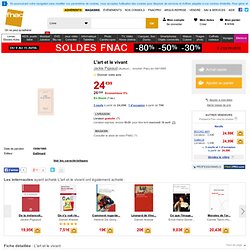
Pour gérer et modifier ces paramètres,cliquez iciFermer Fermer Achat rapide. Simon Penny. First presented: 5th Biennale of Art and Technology, Connecticut College, Feb1995, First published: New Formations UK, 1996. Leonil Nadine LAMENTIN (LE) L Inhibition de l action : Henri Laborit. "L'inhibition de l'action" du Pr Henri Laborit Baudouin Labrique © Cette page est généralement classée N°1 sur Google (recherche sur le mot "inhibition de l'action") "L'inhibition de l'Action", biologie comportementale et de physio-pathologie.

Stelarc. Stelarc, artiste australien du body art, a réalisé vingt-cinq " suspensions " entre 1976 et 1980.
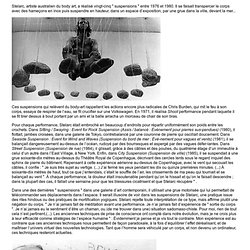
Il se faisait transpercer le corps avec des hameçons en inox puis suspendre en hauteur, dans un espace d’exposition, par une grue dans la ville, devant la mer... Ces suspensions qui relèvent du body-art rappellent les actions encore plus radicales de Chris Burden, qui mit le feu à son corps, essaya de respirer de l’eau, se fit crucifier sur une Volkswagen. David Chavalarias Homepage : Louis Bec : L'art est le vivant. Entretien avec Oron Catts. Face aux questions éthiques brûlantes soulevées par la biotechnologie, de plus en plus d’artistes se consacrent eux aussi à ce thème.

Pour certains, la biotechnologie n’est plus seulement un thème mais aussi un moyen d’expression. L’un des précurseurs de cette tendance est le groupement d’artistes « Tissue Culture & Art » du laboratoire australien pour la collaboration scientifico-artistique « Symbiotica » de Perth, dans l’ouest de l’Australie. Les artistes peuvent y poser eux-mêmes les questions les plus dérangeantes et ont accès à tous les instituts de recherche. Eduardo kac. Kac - French. Eduardo Kac est internationalement reconnu pour ses oeuvres interactives sur le Net et sa pratique en bio art.

Dans les années 80, pionnier de l'art des télécommunications pré-Internet, Eduardo Kac (prononcer "Katz") est reconnu au début des années 90 avec ses oeuvres radicales dans le domaine de la téléprésence. Eduardo Kac propose un "art transgénique" à base d'organismes génétiquement modifiés à des fins artistiques. Après avoir défrayé la chronique avec le projet d'un lapin fluorescent vert (GFP Bunny (2000), ensuite nommé Alba), il s'interroge, dans ses installations Genesis (1999), Le Huitième Jour (2001), et Move 36 (2002/2004), sur les croyances modernes. UNESCO Art, Science & Technology. UNESCO Arts, Science & Technology. Harold Cohen is the former director of the Center for Research in Computing and the Arts (CRCA), was an English painter with an established international reputation when he came to UCSD in 1968 for a one-year Visiting Professorship.

His first experience with computing followed almost immediately, and he never returned to London. UNESCO Arts, Science & Technology. Luc Courchesne was born in 1952 in St-Léonard d'Aston, Québec.
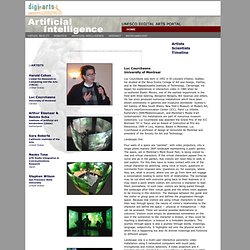
He studied at the Nova Scotia College of Art and Design, Halifax, and at the Massachusetts Institute of Technology, Cambridge. He began his explorations in interactive video in 1984 when he co-authored Elastic Movies, one of the earliest experiment in the field with Ellen Sebring, Benjamin Bergery, Bill Seaman and others. He has since produced numerous installations which have been shown extensively in galleries and museums worldwide: Sydney's Art Gallery of New South Wales, New York's Museum of Modern Art, Tokyo's InterCommunication Center (ICC), Paris' La Villette, Karlsruhe's ZKM/Medienmuseum, and Montréal's Musée d'art contemporain.
UNESCO Arts, Science & Technology. UNESCO Arts, Science & Technology. UNESCO Arts, Science & Technology. UNESCO Arts, Science & Technology. N.
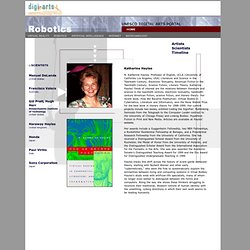
UNESCO Arts, Science & Technology. Francisco Varela, biologist, has died in Paris on May 28.
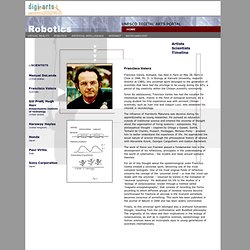
Born in Chile in 1946, Ph. D. in Biology at Harvard University, research director at CNRS, this universal spirit belonged to the generation of scientists that have had the privilege to be young during the 60’s, a period of big creativity within the Chilean scientific community. Since his adolescence, Francisco Varela has had the vocation for intellectual work, mainly in the field of biological sciences. As a young student his first experience was with eminent Chilean scientists, such as Juan Vial and Joaquin Luco, who awakened his interest in neurobiology. UNESCO Arts, Science & Technology. UNESCO Arts, Science & Technology. Goldberg did undergrad work at the University of Pennsylvania and received his Ph.D. from the School of Computer Science at Carnegie Mellon University.

He taught Computer Science at the University of Southern California until 1995 when He moved to UC Berkeley. He currently studies robotics and industrial automation. Currently his work involves the development of algorithms for feeding, sorting, and fixturing industrial parts. They are interested in mathematically rigorous solutions that require a minimum of sensing and actuation so as to reduce costs and increase reliability. UNESCO Arts, Science & Technology. Simon Penny is an Australian artist, theorist and teacher in the field of Interactive Media Art. His art practice consists of interactive and robotic installations, which have been exhibited in the US, Australia and Europe. His current project "Traces" is a telematic interactive environment using networked CAVEs with machine- vision sensing in each CAVE. This project is a development on directions pursued the machine vision driven interactive digital video installation "Fugitive", first shown at ZKM Multimediale5, and again at EMAF98 (European Media Art Festival, Osnabruck).
UNESCO Arts, Science & Technology. Rafael Lozano-Hemmer was born in Mexico City in 1967. In 1989 he received a B.Sc. in Physical Chemistry from Concordia University in Montréal, Canada. Jed berk. Leaf presssings fishfeet hair-looming 2 Nara Pusa ·heir-looming ·organic rubber feather-less. Jed Berk. 11 - jed berk. Jed Berk and the Blubber bots – Autonomous Light Air Vessels (ALAVs) Jed Berk has a lot of shows going! Jed makes our Blubber bot kit in the MAKE store, if you want to make a autonomous blimp, you can! In the pursuit to evolve and grow the biotopes, some of the species have bred forming 500 hundred new young, The Blubber Bots are offspring of the Autonomous Light Air Vessels (ALAVs). The Blubber Bots call for participation from the audience. Through educating an audience from a more hands on experience, Blubber Bots can be assembled and let loose into the world by anyone willing to do so.
I am working toward a more ambitious biotope imagining hundreds of Blubber Bots inhabiting a central location. Untitled. Pascal Meccariello sur artnet. Instalación. Algorithmic Art and Artificial Intelligence. Swam Intelligence. TIPE 2009 - Réseau de neurones. Intelligence Artificielle eBook Downloads. Acquérir des signaux EEG de votre cerveau avec un kit Arduino.
Voici une technique simple qui permet de connecter un simple gadget utilisant vos EEG à un kit Arduino. Vous pouvez ainsi développer de nouvelles applications utilisant l’électroencéphalographie. Une dérivation est réalisée sur le gadget pour être acquisse par le kit Arduino qui mettra en forma les données à l’aide d’un Parser. Dans l’exemple qui suit en vidéo, c’est un modèle de capteur MindFlex de Mattel qui est hacké par un kit Arduino. Tous l’environnement de développement logiciel pour IDE Arduino est disponible sur github.com/kitschpatrol/Arduino-Brain-Library Le logiciel de visualisation des vos ondes est disponible sur github.com/kitschpatrol/Processing-Brain-Grapher plus d’infos sur cette réalisation sont disponible sur ericmika.com. Biomimetics. You Decide Biomimetics Biomimetics involves designing synthetic devices that mimic nature in form and/or function.
Utilizing biomimetics is extremely useful because it typically takes advantage of the fact that in nature functions evolve in unison, so components are multifunctional. This contrasts designs of synthetic systems, in which functions are isolated, such that each component has a single function. When you click on these sites, you may be exiting the NASA web site. How Bioluminescence Works" Animals that use their sense of sight to navigate generally have a hard time getting around without light. Some, like owls, have very large eyes that they use to collect lots of light. They also use their other senses to gather information about their surroundings. Humans, on the other hand, have put a lot of effort into creating portable, often artificial light sources, from torches to light bulbs and LEDs.
Some bioluminescent life forms have an entirely different approach -- they make their own light and carry it around in their bodies. Many animals use the light they produce the same way people use flashlights or searchlights. Vera bighetti on the Behance Network. Vera bighetti. Stereoscopy Space on the Behance Network. Argente. Messages.